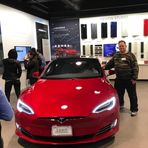The Weight of Change: How Heavy Electric Vehicles Are Shaping Road Safety
February 7, 2025, 3:39 am

Location: United States, Texas, Austin
Employees: 10001+
Founded date: 2003
Total raised: $3.86B

Location: United States, Michigan, Ypsilanti
Employees: 10001+
Founded date: 1896
Total raised: $40K
Electric vehicles (EVs) are rolling into our lives like a freight train. They promise a cleaner future, but they come with a heavy price—literally. As the average EV tips the scales at 20-30% more than traditional gas-powered cars, the implications for road safety are profound. The laws of physics don’t bend for anyone. More mass means more force upon impact. This is a reality that safety experts are increasingly concerned about.
Consider the Ford F-150. The gas version weighs around 4,500 pounds. Its electric counterpart, the Ford F-150 Lightning, weighs over 6,000 pounds. That’s a hefty difference. In a collision, that extra weight translates into greater force. The result? Increased risk for pedestrians and drivers of smaller vehicles.
In the Bay Area, the statistics tell a grim story. Traffic fatalities surged by 48% from 2010 to 2020. In 2010, 317 people lost their lives on the roads. By 2020, that number had climbed to 472. This equates to 1.3 deaths per day. The rise in fatalities correlates with the influx of larger, heavier vehicles on the roads.
Safety experts like Julia Griswold from UC Berkeley’s Safe Transportation Research and Education Center point to a fundamental flaw in how we define safety. Historically, the focus has been on protecting the occupants of the vehicle. The assumption was simple: bigger cars equal safer crashes. But this perspective is myopic. It ignores the broader implications for everyone else on the road.
The auto industry has entered an “arms race” of sorts. Each manufacturer is vying to produce larger, heavier vehicles. A 2013 study from UC Berkeley titled “Pounds That Kill” found that for every 1,000-pound increase in a striking vehicle’s weight, the probability of a fatality in the struck vehicle rises by 47%. That’s a staggering statistic.
The dangers of heavy vehicles were starkly illustrated in a tragic incident in Piedmont, California. A Tesla Cybertruck crashed into a tree, resulting in the deaths of three teenagers. This incident is under investigation, but it underscores the potential consequences of heavier vehicles on the road.
Cities across the Bay Area are grappling with this issue. Initiatives like Vision Zero aim to reduce pedestrian and traffic deaths through various strategies. These include building pedestrian walkways, creating protected bike lanes, and enforcing slower speed limits. However, addressing the problem of larger vehicles is more complex. The car-centric infrastructure in the U.S. makes it difficult to limit the presence of heavy-duty trucks and larger cars.
Griswold emphasizes the challenge. The auto industry needs to be nudged toward a broader understanding of safety—one that includes the safety of others, not just the occupants of the vehicle. This is a tough nut to crack.
The conversation around EVs and safety is not just about numbers; it’s about lives. Every statistic represents a person, a family, a community. As we embrace the future of transportation, we must also consider the consequences of our choices.
The shift to electric vehicles is a step toward sustainability, but it’s essential to balance this with safety. Policymakers need to take a hard look at the implications of heavier vehicles on our roads. Infrastructure must evolve to accommodate these changes.
The auto industry has a responsibility. It must innovate not just for profit but for the safety of all road users. This means rethinking vehicle design, focusing on reducing weight, and enhancing safety features that protect pedestrians and smaller vehicles.
As we move forward, we must remember that safety is a shared responsibility. It’s not just about the driver; it’s about everyone who shares the road. The future of transportation should not come at the cost of lives.
In conclusion, the rise of electric vehicles is a double-edged sword. They offer a glimpse of a cleaner future, but their weight poses significant risks. As we navigate this transition, we must prioritize safety for all. The road ahead is heavy, but with the right measures, we can lighten the load.
The challenge is daunting, but it’s not insurmountable. With thoughtful policies, innovative designs, and a commitment to safety, we can ensure that the future of transportation is not only sustainable but also safe for everyone. The journey is just beginning, and it’s up to us to steer it in the right direction.
Consider the Ford F-150. The gas version weighs around 4,500 pounds. Its electric counterpart, the Ford F-150 Lightning, weighs over 6,000 pounds. That’s a hefty difference. In a collision, that extra weight translates into greater force. The result? Increased risk for pedestrians and drivers of smaller vehicles.
In the Bay Area, the statistics tell a grim story. Traffic fatalities surged by 48% from 2010 to 2020. In 2010, 317 people lost their lives on the roads. By 2020, that number had climbed to 472. This equates to 1.3 deaths per day. The rise in fatalities correlates with the influx of larger, heavier vehicles on the roads.
Safety experts like Julia Griswold from UC Berkeley’s Safe Transportation Research and Education Center point to a fundamental flaw in how we define safety. Historically, the focus has been on protecting the occupants of the vehicle. The assumption was simple: bigger cars equal safer crashes. But this perspective is myopic. It ignores the broader implications for everyone else on the road.
The auto industry has entered an “arms race” of sorts. Each manufacturer is vying to produce larger, heavier vehicles. A 2013 study from UC Berkeley titled “Pounds That Kill” found that for every 1,000-pound increase in a striking vehicle’s weight, the probability of a fatality in the struck vehicle rises by 47%. That’s a staggering statistic.
The dangers of heavy vehicles were starkly illustrated in a tragic incident in Piedmont, California. A Tesla Cybertruck crashed into a tree, resulting in the deaths of three teenagers. This incident is under investigation, but it underscores the potential consequences of heavier vehicles on the road.
Cities across the Bay Area are grappling with this issue. Initiatives like Vision Zero aim to reduce pedestrian and traffic deaths through various strategies. These include building pedestrian walkways, creating protected bike lanes, and enforcing slower speed limits. However, addressing the problem of larger vehicles is more complex. The car-centric infrastructure in the U.S. makes it difficult to limit the presence of heavy-duty trucks and larger cars.
Griswold emphasizes the challenge. The auto industry needs to be nudged toward a broader understanding of safety—one that includes the safety of others, not just the occupants of the vehicle. This is a tough nut to crack.
The conversation around EVs and safety is not just about numbers; it’s about lives. Every statistic represents a person, a family, a community. As we embrace the future of transportation, we must also consider the consequences of our choices.
The shift to electric vehicles is a step toward sustainability, but it’s essential to balance this with safety. Policymakers need to take a hard look at the implications of heavier vehicles on our roads. Infrastructure must evolve to accommodate these changes.
The auto industry has a responsibility. It must innovate not just for profit but for the safety of all road users. This means rethinking vehicle design, focusing on reducing weight, and enhancing safety features that protect pedestrians and smaller vehicles.
As we move forward, we must remember that safety is a shared responsibility. It’s not just about the driver; it’s about everyone who shares the road. The future of transportation should not come at the cost of lives.
In conclusion, the rise of electric vehicles is a double-edged sword. They offer a glimpse of a cleaner future, but their weight poses significant risks. As we navigate this transition, we must prioritize safety for all. The road ahead is heavy, but with the right measures, we can lighten the load.
The challenge is daunting, but it’s not insurmountable. With thoughtful policies, innovative designs, and a commitment to safety, we can ensure that the future of transportation is not only sustainable but also safe for everyone. The journey is just beginning, and it’s up to us to steer it in the right direction.